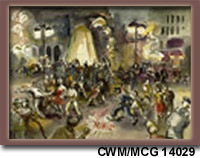George Campbell Tinning was born in Saskatoon and trained at the Eliot O'Hara Watercolour School, Goose Rocks, Maine and the Art Students' League in New York. In 1939 he moved to Montreal, where he established himself as an artist and worked as an illustrator. He never stopped painting and exhibiting, and at the end of his life was creating large abstract compositions in brilliant colours, pictures that were far removed in style and feel from his wartime and immediate postwar subjects.
Tinning began his military career in the 2nd Battalion, Black Watch (Royal Highland Regiment) in June 1942. He was appointed an official war artist in April 1943 and spent the balance of the year in Ottawa. From December 1943 to July 1944 he was posted to London, attached to the Historical Section at Canadian Military Headquarters, before being transferred to the 1st Canadian Division's Historical Section in August 1944, serving in Italy and northwest Europe. He completed his service in Ottawa in 1946 and was released in October of that year with the rank of captain.
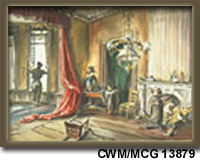
The End of It All
An immediate interpretation of the painting speaks of hope in the midst of trouble, for the soldier seems, by the act of looking out the window, to be gazing at a more promising future. It turns out that the painting was posed and that the model was Tinning's driver.
Tinning was to create the same effect in Spring in Arnhem, Holland. The watercolour that preceded this work did not include the male figure.
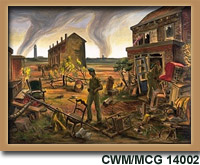
Spring in Arnhem, Holland
Tinning's paintings, particularly his watercolours, demonstrate that regardless of army instructions, or new and sometimes difficult subject matter, what mattered was what he could make of it as an artist. His early 1944 works featuring the 1st Canadian Parachute Battalion practising drops in the Wylye Valley in England capture the quiet, gentle movement of falling parachutes.
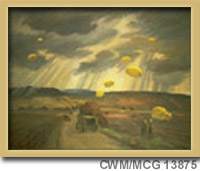
Drifting Down
Drifting Down contrasts the parachutes' curving
shapes with a thundery sky behind, while the light breaks through the clouds in
bright rays that reflect off the parachutes themselves. The painting is true to
the activity it depicts and to the landscape in which it is taking place, and
the two play off each other harmoniously.
Tinning's later work in Italy is particularly fine, for he had an eye for the
telling and the unusual. In the Vault of the Cemetery portrays
off-duty soldiers sheltering in a family tomb during a period of shelling. They
play games, they read, some rest in the still-to-be-filled spaces as they wait
for the battle to die down.
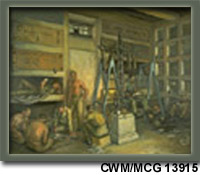
In the Vault of the Cemetery
Family members rush for cover as their windows shatter after a mortar blast.
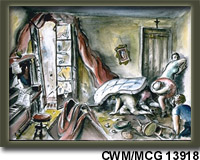
Italian Family under Mortar Fire
In 1973 Tinning saw several examples of his work in a Canadian War Museum exhibition entitled Sicily/Italy 1943-1945. He consequently wrote to Lee Murray, then Chief Curator of the Museum, of his pleasure in seeing these works.
"The two paintings that moved me most both for memories and as pictures were Dante's Tomb, Ravenna and Canadian Graves at the Gothic Line. Dante's Tomb, Ravenna is a very fine water-colour and says for me, what it was like to be in Italy at that time. The colour is poetic and the subject starts one thinking of the crossing of the 13th and 20th century cultures. Canadian Graves at the Gothic Line was done two days after the breaking of that line at Tomba di Pesaro. In black and white I have always considered it lacking in design - rather amateur. Not at all, the olive tree (the symbol of peace) and the grey sky were there and possibly were fortuitous, but their message comes across. I have always hoped that perhaps one or two of the families of the men whose names are on the crosses may have seen this picture."
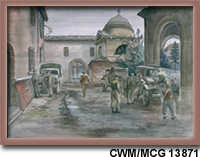
|
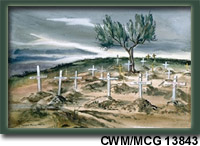
|
| Dante's Tomb, Ravenna | Canadian Graves at the Gothic Line |
Tinning's war artist career ended for all intents and purposes in London. He was there on VJ Day and captured in paint the celebrations in Piccadilly Circus, a lively composition that captures the frenetic nature of the moment. This painting hangs in the Canadian War Museum, where it now represents and celebrates not only a victory for the Allies, but the career of a remarkably talented war artist.
